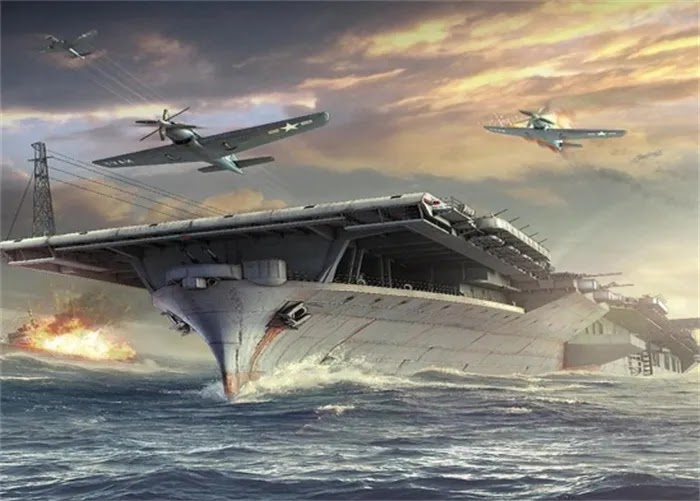Unraveling the Epic Saga of the Largest Naval Battle in World War II
Clash of Titans: Unraveling the Epic Saga of the Largest Naval Battle in World War II
Introduction:
World War II witnessed numerous monumental battles that forever shaped the course of history. Among them, the Battle of Leyte Gulf stands tall as the largest naval confrontation in terms of scale and significance. Spanning several days in late October 1944, this fierce clash between the Allied and Japanese forces in the Pacific Theater showcased the full might of naval power and marked a critical turning point in the war. Join us on a captivating journey as we delve into the details of this legendary battle.
Setting the Stage: The Pacific Theater:
The Pacific Theater of World War II served as a battleground for supremacy between the Allies, led by the United States, and the Axis powers, primarily Japan. The Allies aimed to regain control over the Philippines, a strategic stronghold in the Pacific, while Japan sought to maintain its dominance in the region.
The Prelude: Japanese Forces in Motion:
The Japanese devised a daring plan known as Operation Sho-Go, aiming to cripple the Allied forces and halt their advance. Under this plan, they aimed to divert the attention of the U.S. Pacific Fleet away from the Philippines by launching a decoy attack on the island of Leyte. This diversion would allow their naval forces to strike a decisive blow against the weakened Allied fleet.
The Battle Unfolds: The Four Engagements:
The Battle of Leyte Gulf consisted of four separate engagements that unfolded across the vast expanse of the Philippine Sea. These engagements were the Battle of the Sibuyan Sea, the Battle of Surigao Strait, the Battle of Cape Engaño, and the Battle off Samar.
1. Battle of the Sibuyan Sea:
The first engagement witnessed the fierce confrontation between the Japanese battleship Yamato, the largest battleship ever built, and a squadron of U.S. aircraft carriers. Despite the Yamato's resilience, relentless American air strikes eventually led to its demise. This engagement marked the first blow to the Japanese fleet.
2. Battle of Surigao Strait:
The Battle of Surigao Strait was a nocturnal encounter between the Allied naval forces and the remnants of the Japanese fleet. Utilizing innovative tactics, the Allied forces executed a textbook example of a classic naval "crossing the T" maneuver. The Japanese fleet suffered heavy losses, including the sinking of several battleships, and the balance of power shifted further in favor of the Allies.
3. Battle of Cape Engaño:
The Battle of Cape Engaño saw the Japanese attempting to lure the remaining U.S. aircraft carriers into a trap. However, the Americans, led by Admiral William "Bull" Halsey, skillfully outmaneuvered their adversaries, resulting in the sinking of four Japanese carriers and the virtual annihilation of the Japanese air arm.
4. Battle off Samar:
The Battle off Samar, often referred to as the "Last Stand of the Tin Can Sailors," showcased the extraordinary valor and determination of the U.S. Navy's escort carriers and their supporting destroyers against a vastly superior Japanese force. Through sheer audacity and desperate resistance, the outnumbered American forces managed to hold off the Japanese onslaught, ensuring the success of the Leyte landings.
Outcome and Significance:
The Battle of Leyte Gulf resulted in a resounding victory for the Allied forces, securing their control over the Philippines and effectively neutralizing the Japanese threat in the region.
The outcome of the Battle of Leyte Gulf was a resounding victory for the Allied forces, securing their control over the Philippines and effectively neutralizing the Japanese threat in the region. The battle marked a significant turning point in the Pacific Theater of World War II, as it shattered the myth of Japanese naval invincibility and exposed the vulnerabilities of their fleet.
The loss of the Yamato, along with several other Japanese battleships and carriers, severely weakened Japan's naval power. It also highlighted the effectiveness of American naval aviation and the superiority of their carrier-based aircraft. The battle showcased the critical role of aircraft carriers as the primary instruments of naval warfare in the Pacific, solidifying their position as the new dominant force on the high seas.
Furthermore, the Battle of Leyte Gulf had far-reaching consequences beyond its immediate military impact. The defeat dealt a severe blow to Japanese morale and raised doubts among their leadership about the feasibility of their war strategy. It also accelerated the decline of Japan's industrial capacity and resources, as they could no longer sustain large-scale naval operations.
From a strategic standpoint, the battle paved the way for the eventual liberation of the Philippines and set the stage for the subsequent Allied advance towards Japan itself. It allowed the Allies to establish air and naval bases in the Philippines, which provided crucial support for the later campaigns in the Pacific.
The Battle of Leyte Gulf also highlighted the sacrifices and heroism of the men and women who served in the navies of both sides. The bravery and determination displayed by sailors on both sides were awe-inspiring, with countless acts of valor and selflessness amid the chaos of battle.
However, it is important to acknowledge that the Battle of Leyte Gulf came at a heavy cost. The loss of lives and ships on both sides was significant, underscoring the brutal nature of naval warfare. It serves as a poignant reminder of the human toll exacted by the pursuit of victory during times of war.
Beyond its immediate military and strategic implications, the Battle of Leyte Gulf holds a lasting legacy in the annals of naval warfare. Let us explore some of the long-term impacts and historical significance of this monumental clash.
1. Shift in Naval Warfare Paradigm:
The Battle of Leyte Gulf marked a clear shift in the paradigm of naval warfare. It demonstrated the growing importance of aircraft carriers and naval aviation as the primary offensive force, relegating battleships to a secondary role. The battle showcased the vulnerability of even the mightiest battleships against aerial attacks and emphasized the need for a well-balanced and versatile naval fleet.
2. Japanese Naval Decline:
The defeat at Leyte Gulf dealt a severe blow to the Japanese Navy, both in terms of resources and morale. The loss of their capital ships, including the Yamato, left Japan with a weakened fleet and limited options for further large-scale naval operations. This decline in Japanese naval power paved the way for subsequent Allied offensives, ultimately leading to Japan's surrender in 1945.
3. Allied Naval Dominance:
The Battle of Leyte Gulf solidified the Allied naval dominance in the Pacific. The resounding victory boosted Allied confidence, shattered the myth of Japanese invincibility, and set the stage for the final push towards Japan. The battle showcased the effectiveness of coordinated operations, innovative tactics, and superior intelligence gathering, which further enhanced the Allies' ability to project naval power.
4. Lessons Learned:
The Battle of Leyte Gulf provided valuable lessons for future naval operations. It highlighted the importance of intelligence, air superiority, and effective command and control structures. The successful execution of complex maneuvers, such as the "crossing the T" tactic at Surigao Strait, became a blueprint for future naval battles. The battle also emphasized the significance of combined arms operations, with naval, air, and ground forces working in unison.
5. Human Stories of Heroism:
The Battle of Leyte Gulf was not only a clash of fleets but also a testament to individual acts of heroism and sacrifice. Stories of valor, such as the actions of the escort carriers and their crews during the Battle off Samar, have become legendary. The battle showcased the unwavering determination of sailors and aviators on both sides, highlighting their bravery in the face of overwhelming odds.
6. Commemoration and Remembrance:
The Battle of Leyte Gulf continues to be commemorated and remembered as a pivotal moment in World War II. Memorials and museums dedicated to the battle serve as reminders of the sacrifices made by those who fought. The stories of the battle have been immortalized in literature, film, and historical accounts, ensuring that future generations understand its significance.
In conclusion, the Battle of Leyte Gulf stands as the largest naval battle in World War II, both in terms of scale and significance. It showcased the immense power of naval forces and marked a critical turning point in the Pacific Theater. The battle's outcome not only secured the Philippines for the Allies but also dealt a severe blow to Japanese naval capabilities. The valor and sacrifices of those who fought in this epic confrontation will forever be remembered as a testament to the indomitable spirit of those who served at sea.







